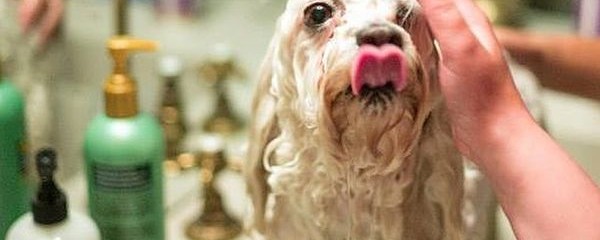DIY Grooming Tips

Grooming pets at home may save money, but it’s also stressful. You won’t come across many cats that like to jump in the bathtub, and some dogs share this sentiment. If your pet has a phobia of the barber’s chair, though, you’ll help alleviate stress (both his and yours) by grooming him yourself instead of taking him to a stranger. Plus, if you have all the proper tools and skills, you can be finished with the entire grooming process in a matter of minutes. Here’s a step-by-step breakdown of how grooming should go, according to the ASPCA:
- Gather. Before you get your pup or kitty worked up about getting a bath, make sure you have everything ready to make it as quick and painless as possible. Gather the necessary tools, including a shampoo appropriate for your dog or cat’s breed and coat, brushes, and a rubber mat to stick in the tub for traction. You’ll also need a big, fluffy towel to dry off your pet after the bath, as well as species-appropriate nail clippers. Optional extras include conditioner for long-haired animals and a cleansing solution for your pooch’s ears (as well as cotton swabs to apply it).
- Prep. Once you have everything in order, it’s time to start prepping your animal. This might actually begin a few days (or weeks) before your first grooming session. Many animals react so strongly to being brushed, bathed, and clipped because they simply aren’t used to being touched on the pads of their paws or paunch of their belly. Spend some time petting and playing with your dog or cat to get her used to this kind of touch. Then, when you are ready to groom her, make the first session short—no more than 5 or 10 minutes. Any longer, and you risk burning the experience into her brain as a lengthy and negative ordeal.
- Brush. Depending on the length of your animal’s fur, you might only need to brush once a week (this guideline applies to short-hair cats and dogs). However, if your pooch or kitty has long, flowing locks, you should make brushing a daily routine. For cats, no matter the length of their fur, you should always start by gently eradicating tangles with a metal comb. Then use a bristle or rubber brush to whisk away any loose hair or dead skin. Most cats will actually enjoy this part of the process. For dogs, you should start with the rubber or bristle brush if the pup has short, smooth hair. Dogs with coarse or long hair need a slicker brush first to get out any knots, then a bristle brush to grab flyaway hairs and dead skin. Don’t forget the tail!
- Clip. Again, you should prep your animal for the foreign touch necessary for nail-clipping long before you take out the clippers. For both pups and cats, you should grasp a paw at a time and push gently where the pad meets knuckles so that their nails extend. Then use sharp clippers to make quick cuts just below where the nail starts to curve. Cut any higher, and you risk hitting a vein. Dogs may need you to file down any rough edges with an emery board (cats will take care of the smoothing-out process themselves, especially if you have a scratching post at the ready).
- Bathe. You really only need to incorporate bath time every three months for dogs, unless he gets dirty in between scheduled baths. Cats rarely need to be bathed, since they’re naturally programmed to keep themselves clean. If you notice your cat getting oily or her fur becoming matted, however, it’s bath time. For felines, fill the tub with about three or four inches of water (put down a rubber mat first), then lather up, rinse (with a pitcher or large cup), and repeat until the soap is all gone. Dry with a big towel. Follow the same procedure for dogs—you can use a hair-dryer to get rid of any lingering water if he enjoys it.
Groom Your Cat [ASPCA]
Groom Your Dog [ASPCA]
Image: http://commons.wikimedia.org/wiki/File:Dog_wash_%2814787059819%29.jpg
Attribution: CC BY 2.0/ Flickr/Christopher Michel